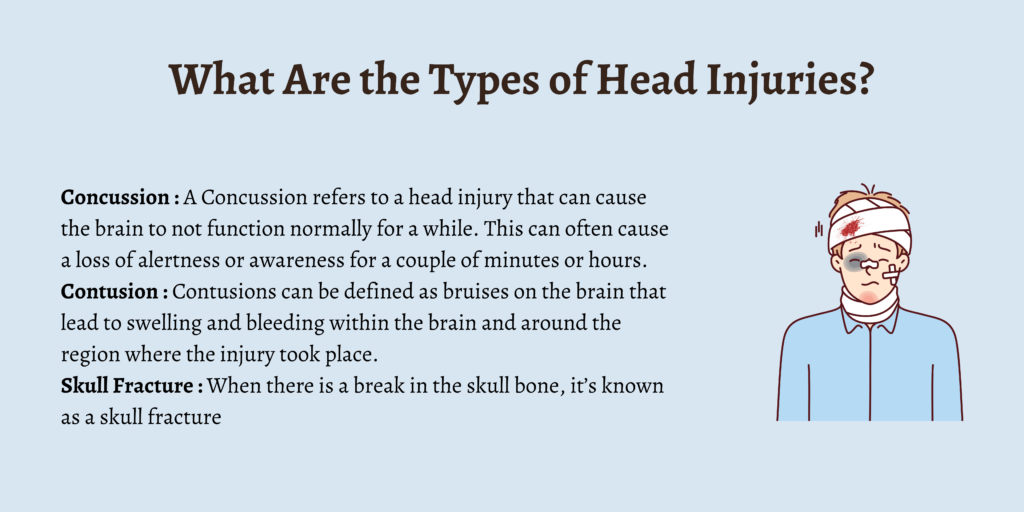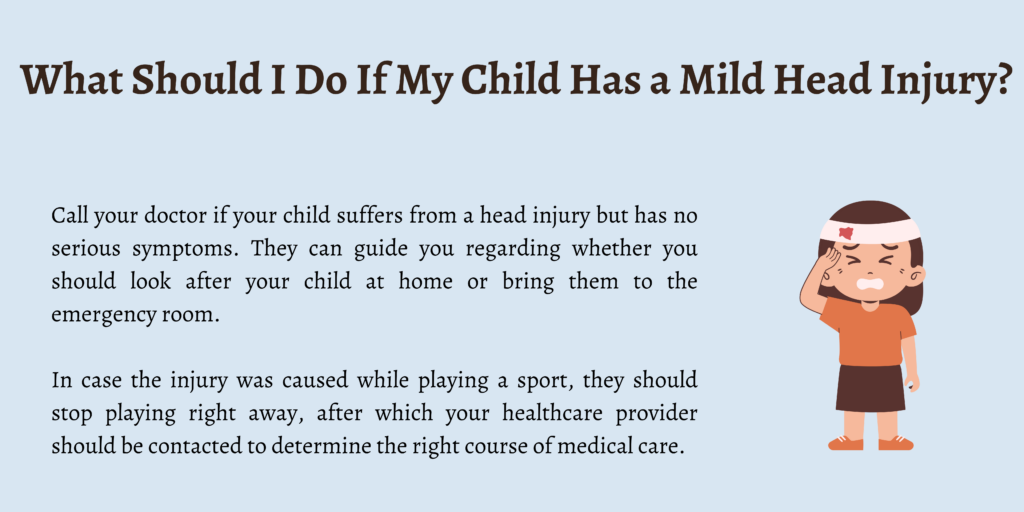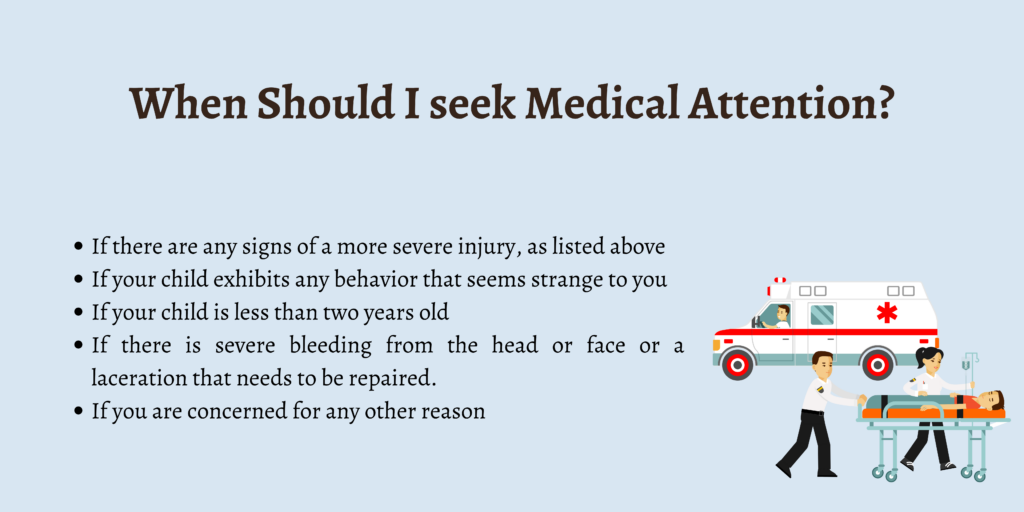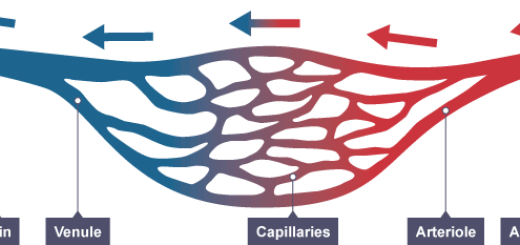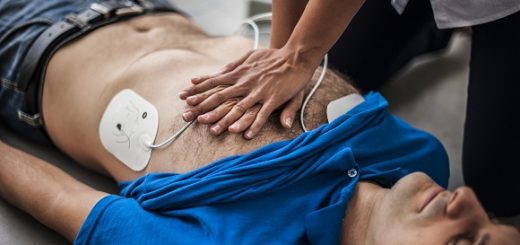Head Injuries in Children
A head injury refers to any sort of damage caused to the brain, skull, scalp, or other blood vessels or tissues in the head. Based on the depth of a person’s injury, a head injury is also often referred to as a traumatic brain injury (TBI) or brain injury.
Head injuries can present themselves as bumps, bruises, or cuts on the head. They can also be visible as open wounds or deep cuts, concussions, internal bleeding, broken skull bones, or damage to the brain.
A head injury is known to be one of the most common causes of death and disability among children. In this article, we will be discussing the various types of head injuries, how they are diagnosed and treated, how they can be prevented, and so on.
What Are the Types of Head Injuries?
The different types of head injuries are as follows:
Concussion
A concussion refers to a head injury that can cause the brain to not function normally for a while. This can often cause a loss of alertness or awareness for a couple of minutes or hours. Certain concussions are brief and mild, so they can’t always be detected immediately.
Contusion
Contusions can be defined as bruises on the brain that lead to swelling and bleeding within the brain and around the region where the injury took place. A contusion can also occur on the opposite side of the head due to the brain hitting the skull.
Skull Fracture
When there is a break in the skull bone, it’s known as a skull fracture, and they are of the following types:
- Linear skull fracture: In a linear skull fracture, the bone doesn’t move due to the break, and treatment isn’t usually required for such a fracture.
- Depressed skull fracture: With depressed skull fractures, a part of the skull develops a sunken appearance at the spot of the broken bone. Surgery could be needed for this if the skull’s inner part gets pressed against the child’s brain.
- Diastatic skull fracture: In a diastatic skull fracture, the skull’s suture lines get affected. The skull of a child is made up of bony plates that enable the skull to grow. The borders where the intersection of the plates takes place are known as suture lines. These fractures widen the normal suture lines.
- Basilar skull fracture: If a child suffers from a basilar skull fracture, the bone located at the base of the skull gets impacted. Children who face these fractures could have a bruise behind the ear or bruises around the eyes.
What Are the Symptoms and Signs of a More Severe Head Injury?
- Confusion, drowsiness, or loss of consciousness
- Irritability or restlessness
- Crying that lasts more than ten minutes
- Initial improvement followed by deterioration
- Clumsiness, dizziness, or difficulty walking
- Fluid or blood leaking from the ears or nose
- A headache that is constant and/or worsening
- Vomiting more than once
Which Children are at Risk of a Head Injury?
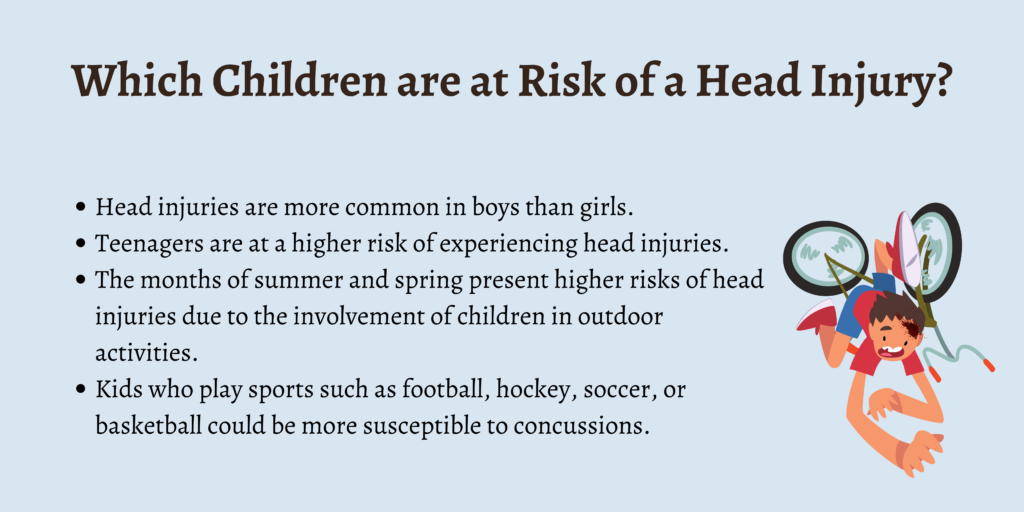
Here is what you should know about the risk of head injuries in children:
- Head injuries are more common in boys than girls.
- Teenagers are at a higher risk of experiencing head injuries.
- The months of summer and spring present higher risks of head injuries due to the involvement of children in outdoor activities.
- Kids who play sports such as football, hockey, soccer, or basketball could be more susceptible to concussions.
How Are Head Injuries Diagnosed?
The doctor will ask about your child’s recent injuries, medical history, and symptoms. After conducting a physical exam, they could recommend the following tests:
- Blood test
- X-ray
- CT scan
- MRI
What Should I Do If My Child Has a Mild Head Injury?
Call your doctor if your child suffers from a head injury but has no serious symptoms. They can guide you regarding whether you should look after your child at home or bring them to the emergency room.
In case the injury was caused while playing a sport, they should stop playing right away, after which your healthcare provider should be contacted to determine the right course of medical care.
What Should I Do If My Child Has a Serious Head Injury?
Call the emergency medical services immediately if your child has a head injury and displays the following symptoms:
- Passing out or losing consciousness
- Having a seizure
- Not responding
- Vomiting hours after the head injury or vomiting more than twice
- Having a wound that bleeds profusely
- Not being able to recollect the events that transpired
- Having behavioral changes, such as confusion or agitation
- Stumbling or feeling dizzy
- Having a headache that keeps getting worse
In case your child isn’t breathing, perform CPR on them. If the injury results in bleeding, maintain firm pressure on it till the bleeding stops. Don’t move your child unless they are in an unsafe location, as it could injure them further.
What If There are Changes in My Child’s Condition?
Call your doctor immediately if your child displays any changes in their current condition. You might need to pay a visit to your doctor or rush to the hospital.
Monitoring a Child After a Head Injury
After a child experiences a head injury, they are required to be observed closely at home to determine if the injury is getting worse or not. They will require immediate medical attention if they:
- Develop a worsening or severe headache
- Vomit four to six hours post the injury or vomit twice
- Have a stiff neck
- Feel confused or act oddly
- Have a seizure
- Look ill or can’t stop crying
- Feel drowsy or can’t wake up easily
- Face difficulty in talking, walking, or seeing things
A phone call to the healthcare provider or a follow-up visit to the doctor is usually recommended within 24 hours after the occurrence of the head injury. This is so that the child’s behavior can be monitored, and it can be ensured that they are feeling well and are no longer displaying signs of injury.
When can I treat the injury at home?
Children can be observed for 24 hours at home if they do not display any of the above signs and symptoms and:
- Are older than two years
- Do not have any neurological disease or developmental delay
- Do not have a bleeding disorder
- Do not have a possible neck injury
- Are alert and act normal after a brief period of crying
- Do not take any blood thinning medications such as aspirin or warfarin (coumadin)
How is a Head Injury Treated in a Child?
The treatment of head injuries in kids depends on the following:
- Type and extent of head injury
- Age
- Overall health
- Medical history
- Tolerance levels for specific therapies, procedures, and medicines
Based on how severe the injury is, the treatment could include:
- Rest
- Observation
- Stitches
- Ice
- Surgery
- Hospitalization so they can be observed
- Diagnostic tests
- Adhesive bandage and topical antibiotic ointment
- Assistance with breathing
First Aid Measures for Head Injuries
Check the child’s airway, breathing and for signs of circulation. Start CPR if necessary. Remember to minimize neck movement as much as possible.
If your child is unconscious, assume that there is a possible spinal injury and stabilize her head between your hands while help arrives. If vomiting occurs, roll the head, neck and body as one unit. Try to avoid twisting your child’s neck.
Stop any bleeding by compressing bleeding areas with gauze or a clean cloth. If a fracture of the skull is suspected, do not apply direct pressure to the fracture.
What not to do:
Do not move a child if a more severe head injury is suspected unless your child is unconscious and you are unable to check for breathing. For example, if they are lying face down.
Lifelong Considerations for a Child with a Head Injury
Once a child suffers from a head injury:
- Ensure that the environment they play in remains safe.
- Ensure they wear a seatbelt in the car or a helmet while riding a bike or participating in physical activities such as skateboarding or in-line skating.
- Implement rehabilitative measures in case the child goes through a serious head injury.
What Are Possible Complications of a Head Injury in a Child?
Some of the possible complications in connection to head injuries in children are as follows:
- Losing muscle function
- Loss of taste, hearing, vision, or speech
- Short-term or long-term changes in behavior or personality
What Causes Bruising and Internal Damage to the Brain?
Bruises to the brain and damage to the blood vessels and internal tissues can be caused due to:
- Direct blow to the head.
- Whiplash-like injuries, such as accidents in motor vehicles.
- A child being shaken, such as in instances of child abuse.
- A coup lesion, wherein a trauma-related bruise occurs at the spot of impact.
When Should I seek Medical Attention?
- If there are any signs of a more severe injury, as listed above
- If your child exhibits any behavior that seems strange to you
- If your child is less than two years old
- If there is severe bleeding from the head or face or a laceration that needs to be repaired.
- If you are concerned for any other reason
How to Prevent Head Injuries in Children
Listed below are some of the ways to prevent head injuries in children:
- Childproof your home.
- Make sure proper car seats and booster seats are installed and that they always wear a seatbelt.
- See to it that they have a helmet on for activities such as rollerblading, skateboarding, and skiing.
- Take them to playgrounds where the ground is soft.
- Discuss with your child’s coach about briefing all the kids regarding the safety rules while playing a sport.
- Talk to your kid and ask them to never hide a head injury or be scared about discussing it.
FAQs
1. What are the different types of head injuries?
The different types of head injuries are concussions, contusions, or skull fractures.
2. What are the signs of a head injury in a child?
The signs of a head injury in a child are headaches, confusion, nausea, blurred vision, lack of energy, and tiredness.
3. What are some of the causes of head injuries in children?
Some of the causes of head injuries in children include falling, sports injuries, and child abuse.
4. How can head injuries in children be prevented?
A couple of ways to prevent head injuries are to ensure a safe playing environment for them and making sure they wear seatbelts while being in a car.
5. What are the tests suggested to diagnose head injuries?
The tests suggested to diagnose head injuries include blood tests, MRI scans, X-rays, and CT scans.
Conclusion
If your child suffers from a head injury, get in touch with your doctor in case they develop new symptoms or if their current symptoms get worse or don’t get better.
The speed at which a child recovers from a head injury depends on the kind of injury and the presence of other medical issues. As they recover, it’s vital to maximize their abilities as much as possible within the home, community, and educational environment.
By encouraging them, you can boost their self-esteem and help them regain their independence following the injury so they can continue to lead a normal life.

